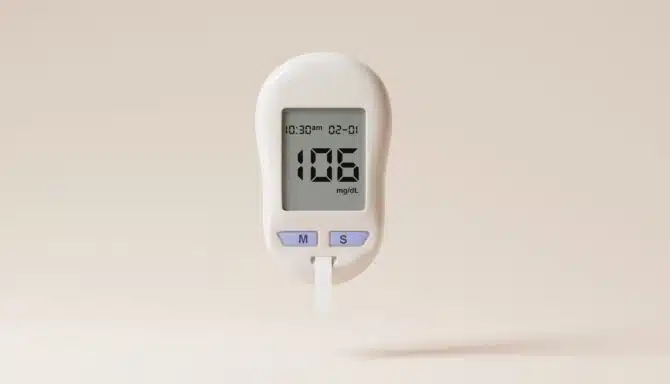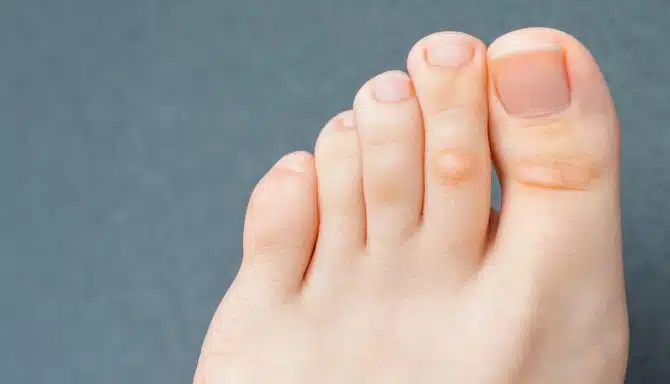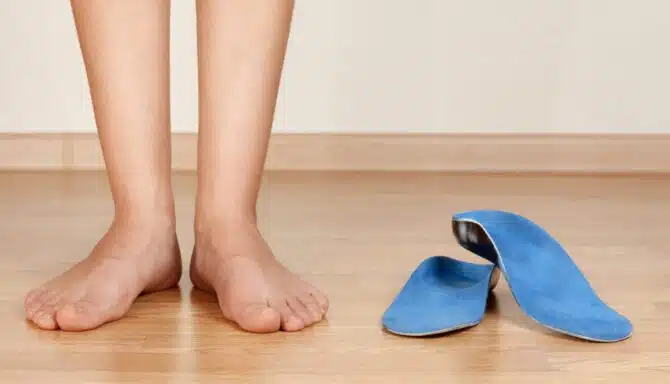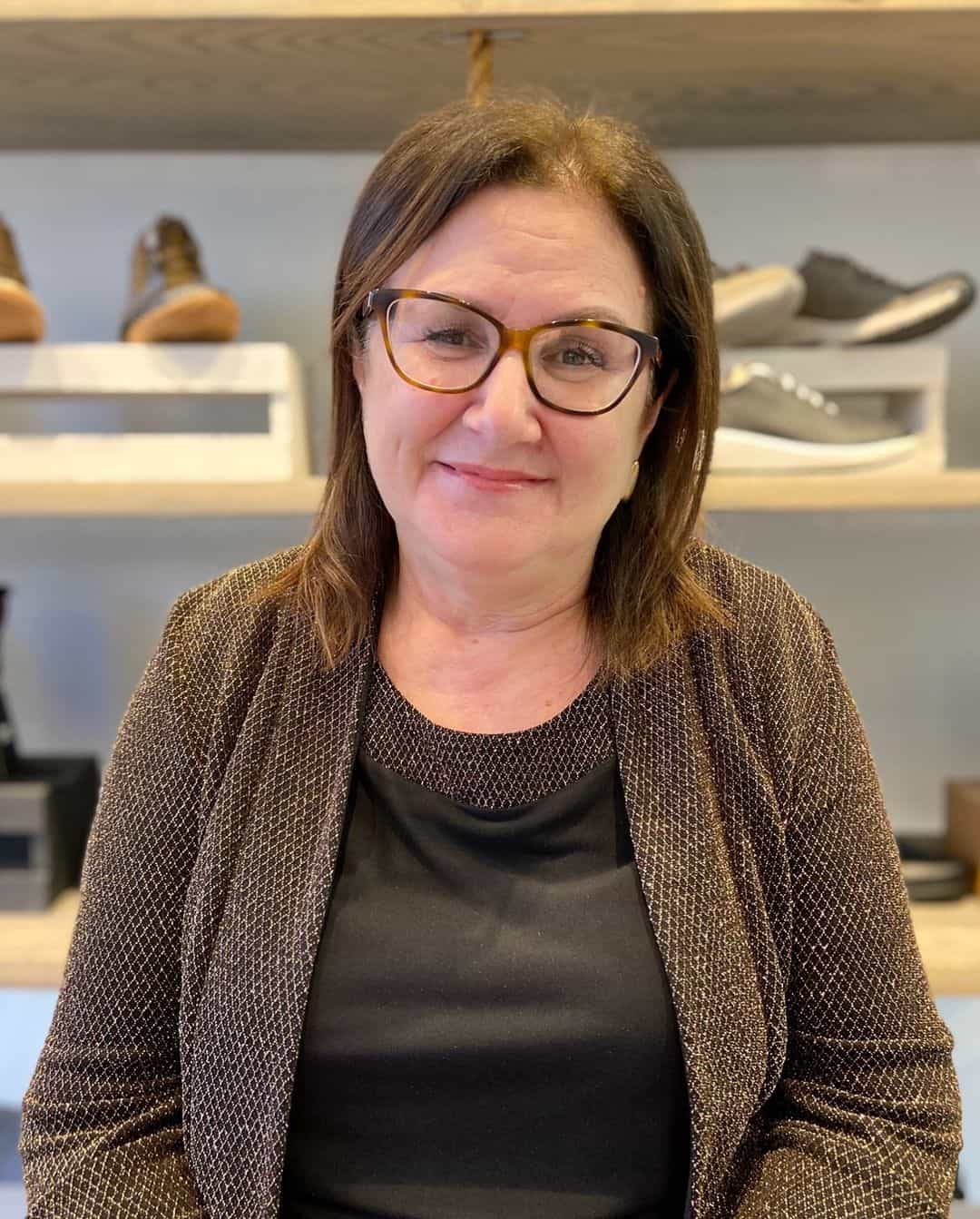June 24, 2024
Oh no, yellow feet! This seemingly alarming skin pigmentation is not usually cause for concern and is far more common than you think. Yellow feet commonly present as yellow bottoms of the feet and are usually not an immediate emergency. That said, they should be looked at during a foot assessment as there may be underlying medical causes or dermatological conditions at play. Let’s review the top culprits for yellow skin on the bottom of your feet.
Calluses and Corns
If the yellow skin on your feet feels hard to the touch and only occurs in certain spots (the whole foot isn’t yellow), you probably just have a lot of thick calluses!
Imagine your feet are like well-trodden paths; the more you walk on them without protective footwear, the thicker and tougher they become, forming “callused armour” which often has a yellow hue.
One of the most well-known podiatric concerns, calluses can be treated if they become a problem for hygienic reasons and also to prevent them from becoming more painful, infected or ruining your skin’s integrity and strength.
Corns can also cause thick, yellow skin.
Calluses and corns can be easily removed by a chiropodist using sterilized, medical-grade equipment. Read more about how our chiropodists treat calluses.
Hyperkeratosis
A dermatological condition called hyperkeratosis causes excessive hard and yellow calluses that can cover the majority of the bottom of your foot. When combined like this they can be a lot worse than solitary calluses and are more likely to crack, bleed, and hurt.
Carotenemia
You are what you eat! And in this case, you may be eating too many carotene-rich foods (like carrots, sweet potatoes, pumpkins — anything orange!) if the entire bottom of your foot has a mild, yellow hue. The good news? This is harmless.
While noticing this effect on the bottom of the feet can be disconcerting, it may also occur on your face, which might have a positive effect on your confidence. Studies show these mild, facial skin changes can contribute to the overall appearance of health and vitality in humans. Pretty cool!
Jaundice
Jaundice is a serious occurrence that points to a poorly functioning liver, gallbladder or pancreas. Your doctor will help you determine the root cause.
A tell-tale sign that you’re experiencing jaundice is if the yellow colour is quite strong, and if the whites of your eyes are also yellow (sclera).
If you don’t have any other symptoms outside of mildly yellow feet, it’s unlikely you have jaundice, but it’s better to be safe than sorry!
Fungal Infections
Athlete’s foot causes flaky and itchy skin clusters around your toes and the ball of the foot. They look red or pink when irritated, but sometimes turn whitish yellow. Don’t try to treat this at home - you might damage your skin and nail health. Seek guidance from your local Toronto foot clinic instead! They can point you towards the right ointments, creams and other treatments. Learn more about treatment and prevention.
Anemia
This medical condition affects your red blood cells and impairs oxygen flow throughout your body. The entire foot or entire bottom of the foot will have a bright, yet mild, yellow tint. If your feet are cold to the touch in addition to being yellow, you might have anemia.
May 30, 2024
As summer approaches, our feet emerge from the confines of socks and boots, ready to step into sandals and flip-flops. However, after months of neglect and hiding, our feet may not be in the best condition to be on display. This is where medical pedicures come in—a treatment that goes beyond mere aesthetics. Let's delve into the benefits of medical pedicures and why they should be on everyone's summer to-do list.
Professional attention to foot health
Unlike traditional pedicures, medical pedicures are performed by trained professionals called chiropodists. They prioritize foot health, ensuring your feet are healthy and feel good. Chiropodists are equipped to address various foot conditions such as calluses, corns, ingrown toenails, and fungal infections. They can also notice and diagnose other things that may be cause for concern, like poor circulation, warts, flat feet, and other foot conditions that may be affecting you. Most importantly, chiropodists can provide professional tips and advice on foot care.
Preventative foot and nail care
Regular medical pedicures can help prevent many standard foot problems before they even start. Addressing issues like calluses and ingrown toenails early on can avoid more severe complications. In addition, toenails grow faster in warm weather, so a medical pedicure in the summer is timely.
Customized treatment
Medical pedicures are tailored to your specific foot needs. Whether you have dry, cracked heels, thickened toenails, or sensitive skin, the treatment can be adjusted to address your concerns effectively. Chiropodists will assess your feet and recommend the appropriate action, ensuring you receive personalized care at every step.
Hygiene and safety
One of the primary benefits of medical pedicures is the emphasis on hygiene and safety. Sterilized instruments, disposable blades and discs, and stringent cleanliness protocols are standard practice in foot clinics. All cleaning protocols are regulated by Health Canada and the College of Chiropodists of Ontario. This reduces the risk of infection and ensures a safe, worry-free experience, especially those with compromised immune systems or diabetes.
Stress relief
It's worth remembering the relaxing aspect of a medical pedicure. Beyond the therapeutic benefits for your feet, the experience can be incredibly soothing for your mind and body. Taking time out of your busy schedule to pamper yourself can lower stress levels, improve mood, and enhance overall well-being.
December 21, 2023
Diabetes is a chronic condition experienced by millions of people worldwide, including 11 million Canadians. Chances are, diabetes affects you, or someone you're close with. Diabetes can have a significant impact on various aspects of your health, including your feet.
Foot health is a top priority for individuals with diabetes, as the condition can lead to a range of complications that affect the lower extremities.
Understanding the connection between diabetes and foot health can help you address the condition and thwart potential issues. In this blog post, you'll learn more about how diabetes and foot health concerns are intertwined.
The link between diabetes and foot health
Diabetes is known to cause problems related to blood circulation and nerve function, and these issues can take a toll on your feet. Here are some key factors to consider:
1. Poor blood circulation
Diabetes can damage blood vessels, reducing blood flow to the feet. This diminished blood circulation can result in slower wound healing and an increased risk of infection.
2. Neuropathy
Diabetes often causes peripheral neuropathy, a condition characterized by nerve damage that predominantly affects the feet and legs. Neuropathy can lead to numbness, tingling, or a loss of foot sensation. Reduced sensation makes it difficult to detect injuries, blisters, or sores. This lack of sensation increases the risk of complications.
3. Foot ulcers
Diabetes patients are prone to developing foot ulcers due to reduced sensation and delayed healing. Ulcers may become infected and become more severe if not addressed promptly.
4. Calluses and corns
Diabetes can alter foot anatomy, leading to abnormal pressure points on the feet. These pressure points can form calluses and corns, causing foot discomfort and an increased risk of ulcers.
5. Fungal infections
Diabetes is thought to cause dysfunction of the immune response. A weakened immune system fails to control the spread of invading pathogens. As a result, those with diabetes are at a greater risk of fungal infections, like athlete's foot and toenail fungus.
6. Reduced ability to heal
Elevated blood sugar levels can impair the body's ability to heal wounds. Even minor cuts, blisters, or abrasions can become problematic if improperly managed or untreated.
How to care for your feet when you have diabetes
Proper foot care is critical for individuals with diabetes. To maintain good foot health and minimize the risk of complications, consider the following tips:
Regular foot inspections
Perform daily foot checks to look for any signs of injury, blisters, sores, or changes in colour and temperature. Early detection is critical to preventing more significant problems. You can also schedule annual foot assessments at Feet First Clinic, during which a chiropodist will thoroughly examine your feet and your foot health history.
Maintain healthy blood sugar levels
Aim to keep your blood sugar within the target range your healthcare provider recommends. Controlling your blood sugar levels will help your overall health, including your feet.
Choose appropriate footwear
Opt for comfortable, well-fitting shoes that reduce the risk of pressure points and provide adequate support. We carry a wide range of footwear and orthapedic footwear here at Feet First Clinic. See more in our complete guide on how to choose the perfect pair of shoes for you and your feet.
Moisturize your feet
Keep your skin hydrated to prevent dryness and cracking. Avoid applying lotion between the toes to prevent fungal growth.
Trim your nails carefully
Trim your toenails straight and avoid cutting them too short to prevent ingrown nails. People with diabetes should avoid nail salons. Instead, you should see a chiropodist for routine diabetic foot care. That way, you feel comfortable knowing the trimming is performed correctly.
Stay active
Engage in regular physical activity to promote better circulation. If you have trouble being physically active, consider low-impact activities like swimming, stationary cycling, or walking.
October 23, 2023
Menopause and foot health have an indirect relationship. In other words, the symptoms and body changes you experience during this time can eventually cause foot conditions. On the bright side, foot problems during menopause are usually not serious and within one’s control. This is a relief for women who have enough to deal with during this challenging time!
Today we’ll investigate what happens to your feet during menopause and what prevention strategies and foot care routines you can master to keep your feet feeling happy and healthy.
Photo by iStock
Hard and Dry Skin
Studies show that estrogen aids in the prevention of skin aging by retaining moisture. So when menopause hits and estrogen levels drop, the padding on the heel of the feet can become hard and dry over time. This may lead to cracked heels, which may become progressively more painful if you don’t treat them.
What You Can Do
Practice a healthy self-care / foot care routine with an emphasis on moisturizing at least twice per day. Try Gehwol medicinal products with added urea.
Burning Feet
While hot flashes and night sweats are not always fully understood by medical experts, for those going through menopause they are very real. Somewhat related are the burning sensations also felt in the feet, which may be caused by poor circulation and dropping estrogen levels.
What You Can Do
Submerge your feet into a nice, warm (not too hot!) foot bath to help with circulation. Make the most of it by adding a Gehwol bath salt product to the water. You can also work on improving your circulation by practicing easy, low-impact foot exercises.
Photo by Macrovector From freePik
Plantar Fasciitis
Plantar fasciitis and heel pain in menopausal women starts with collagen reduction, according to Foundation Podiatry. This causes less elasticity in the plantar fascia and the resultant pain. Furthermore, menopausal weight gain can cause you to place excessive pressure on the feet and change your walking patterns, causing even more discomfort.
What You Can Do
Orthopedic shoes and custom orthotics can help correct your walking patterns and ease the symptoms of menopausal foot pain.
Photo By iStock
Corns, Blisters and Calluses
Abnormal gait patterns, placing pressure on vulnerable parts of the feet due to weight gain, and less healthy skin can all lead to more painful little nuisances for your feet. Years of wearing ill-fitting shoes are also not doing you any favours when it comes to skin issues for your feet.
What You Can Do
A chiropodist can remove and smooth corns and calluses, and treat painful blisters. You can also try products like corn and blister pads. Most importantly, you should ensure you always wear comfortable, well-fitting shoes (a shoe fitting can set you up with the right pair).
Photo by FreePik
June 15, 2023
Corns are one of the most common foot conditions, and quite frankly, they can be a real nuisance. They can target anyone but may occur more frequently in women and older people. While they aren't usually a cause for alarm, chronic foot corns can be painful and affect your quality of life. Let's look at what causes foot corns and what you can do to prevent and treat them.
Causes of Foot Corns
The American Academy of Dermatology notes that friction and pressure on the skin can lead to corns. Here are some everyday lifestyle factors that build friction and may lead to corn formation:
Wearing high heels often
Wearing shoes that are the wrong size
Wearing uncomfortable shoes
Not wearing socks with your shoes
Irregular walking motion / abnormal gait
Foot corns are a protective response to friction and an attempt to shield the skin beneath them. The hardened layer is your body's method of preventing skin ulceration.
Corn Treatment and Prevention of Corns
Preventing foot corns involves attentive foot care and protecting your foot health by wearing the right shoes and avoiding friction on the toes (where corns usually form).
Furthermore, NHS explains how your podiatrist or chiropodist can remove corns if they're severe or may be infected. You should also consider consistent corn removal (corns often come back) if you have diabetes, poor heart health, or blood circulation problems. People with these issues can see minor corns become serious, painful wounds.
A shoe fitting can help prevent foot corns by guaranteeing a proper fit and preventing friction
Here are some safe and common preventative measures and foot corn treatments:
Corn removal techniques, like gently shaving down the corn with medical grade, sterilized tools (performed by a chiropodist)
Products like toe pads or medicated patches
Custom orthotics to properly align your feet and prevent friction
Footwear modifications to ensure a better fit (consider a shoe fitting)
Keeping your feet clean
Soaking a corn in warm water
Applying moisturizing products to the toes
Remember: never try to remove a corn yourself, as this can leave a dangerous opening in the skin that welcomes infection.
June 1, 2023
When it comes to custom orthotics for women, improved foot health is just around the corner. These days, women from all walks of life are enjoying the benefits of orthotics, from foot pain management to better posture and mobility. These perks combined reduce the average woman's chance of developing a painful foot condition. Let's look at how orthotics are becoming one of the best ways to support women's health.
The Benefits of Custom Orthotics for Women
Foot pain management
Better posture
Improved mobility
Foot Pain Management
Many women spend most of their time on their feet and use custom orthotics to relieve and prevent pain. WebMD notes top orthotic features that accommodate pain:
Alignment and support: This corrects imbalances and abnormalities, distributing weight more evenly and reducing strain on the areas of the feet that need a break.
Shock absorption and cushioning: Orthotics with shock absorbing qualities reduce the harsh impact of walking on the pavement and ground.
Offloading, protection and injury prevention: Orthotics can offload specific areas of the foot or relieve pressure on injured or sensitive areas. This promotes healing and prevents irritation.
Women with plantar fasciitis and sore spots on their feet (like blisters, painful corns, etc.) should try "soft orthotics" that have extra cushioning. "Rigid orthotics" are best for daily walking and working on your feet as they prevent strain and the resulting domino effect (pain throughout the lower extremities, hips, knees and back) that comes with wear and tear. If you're interested in orthotics, ask your chiropodist what type are best for your lifestyle.
Posture
Standing tall and maintaining good posture is important to a lot of women. It can boost self-confidence and mental well-being, but most importantly, it works wonders for your health by keeping your bones and muscles in proper alignment.
Since orthotics address the misaligned position of your feet, they are a successful method of improving posture. According to the Journal of Applied Biomechanics, wearing custom orthotics over a certain period can support postural stabilization. This can help women by preventing circulation issues and the vast array of other problems that stem from poor posture. Better Health notes back pain, spinal dysfunction, joint degeneration (which can exacerbate osteoarthritis), rounded shoulders, headaches and muscle fatigue as side effects of bad posture.
Improved Mobility
For women struggling with daily movements, orthotics can make a world of difference. Many women adopt poor walking gaits to accommodate pain, but don't realize the long-term effects this can have. Moreover, issues like overuse injuries or arthritis can negatively impact quality of life.
Luckily, orthotics enhance stability and provide more control with every step, mainly due to the support they give your foot arches. They reduce excessive motion or overpronation (inward rolling of the foot) during walking and ensure each movement has a purpose.






